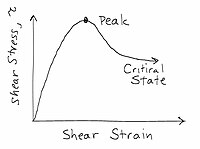
Photo from wikipedia
Quasi-brittle materials such as rock are rate sensitive materials and their behaviour under dynamic loading is not identical with that under static loading. In this study, numerical Brazilian tensile tests… Click to show full abstract
Quasi-brittle materials such as rock are rate sensitive materials and their behaviour under dynamic loading is not identical with that under static loading. In this study, numerical Brazilian tensile tests are conducted using a Split Hopkinson Pressure Bar system in an attempt to reproduce the dynamic increase factors (DIF) of the experimental tests. The rock is modelled by a bonded particle system made of spherical particles which interact at the contact points. The numerical results indicate that while the bonded particle system with a simple contact bond model can closely mimic the static behaviour of the sandstone specimens, it lacks what is needed for a rate dependent material. Therefore, a micromechanical model in which the contact bond strength is allowed to vary in proportion to the relative velocity of the involved particles is introduced. It is shown that the modified model can reproduce the physical tests data reported in the literature. In particular, with the application of strength enhancement coefficients in the range of 0–16 × 105, DIF values of 1.1–13 are obtained in the indirect tensile Brazilian tests, and the induced strain rate in the specimen is in 10–1000 s−1 range. Our preliminary study indicates that the model, consistent with the fact reported for the quasi-brittle materials, shows different rate-dependent sensitivity and dynamic strength enhancement in tension and compression. The micromechanical parameters in the proposed model can be adjusted to reproduce the physical rock strength, and that the shape of the reflected and transmitted numerical waves can be modified to approach those in the physical tests.
Journal Title: International Journal of Civil Engineering
Year Published: 2020
Link to full text (if available)
Share on Social Media: Sign Up to like & get
recommendations!